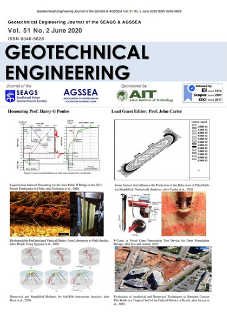Deep Compaction of Sand Causing Horizontal Stress Change
Main Article Content
Abstract
Deep soil compaction is usually required for the control of total and differential settlement, and mitigation of liquefaction. An important, often neglected aspect, is the increase in horizontal stress which occurs due to deep compaction. The increase in horizontal stress means that also the preconsolidation stress and thus the overconsolidation ratio have increased. Re-analysis of calibration chamber tests employing CPT and DMT soundings show that both the CPT and DMT can measure changes in horizontal stress and, thus, be used to show a simple relationship between the increase in horizontal stress index from DMT and the overconsolidation ratio. The application of the tangent modulus method is illustrated using information by CPT and DMT. A hypothesis is proposed that explains aging effects in compacted soil by the redistribution of horizontal stresses after treatment. The significance of the overconsolidation ratio for the liquefaction resistance of loose, water-saturated soils is illustrated. The increase in effective stress due to compaction is of significance for analysis of compacted fill, and in particular for the assessment of settlement. Stress changes due to compaction are also important for other types of advanced geotechnical analyses.
Article Details

This work is licensed under a Creative Commons Attribution-NonCommercial-NoDerivatives 4.0 International License.
Copyright © 2019 Association of Geotechnical Societies in Southeast Asia (AGSSEA) - Southeast Asian Geotechnical Society (SEAGS).


